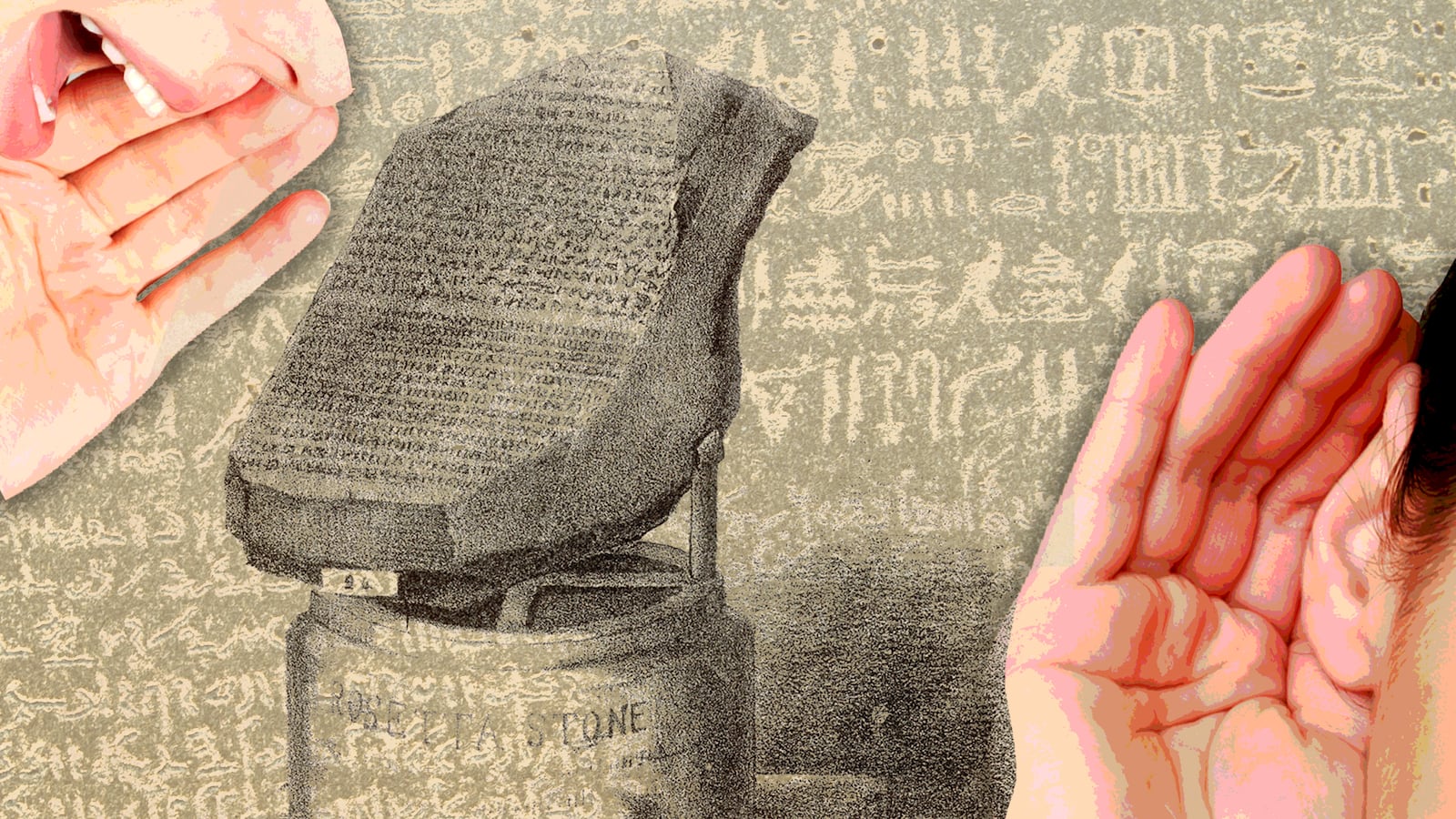It sounds like the premise for the Terminator trilogy: Facebook chatbots developed by the Facebook Artificial Intelligence Research lab have invented their “own language” for negotiating with one another. In other words, they invented a non-human language that we mere people can’t understand. The announcement made news almost 218 years to the day after the discovery of the Rosetta Stone.
The Rosetta Stone, of course, made the deciphering of hieroglyphics possible for the modern period, but there are still ancient languages that we don’t understand, and one's indecipherability led to the execution of an archaeologist by the Nazi allies.
The Rosetta Stone was discovered in 1799, by a French soldier named Pierre Bouchard during Napoleon Bonaparte’s Egyptian campaign. The four feet by two-and-a-half feet black basalt slab was discovered about thirty-five miles north of Alexandria at a fort near the town of El-Rashid (Rosetta). The Stone, as we all know, was inscribed in three languages: ancient Greek, hieroglyphics, and demotic (a late Egyptian script used in the Nile Delta). The Greek text announced that the slab was dedicated by priests to Ptolemy V, the Greek ruler of Egypt in the second century BCE and mentioned that all three inscriptions were identical in content. It was, in other words, the key that cracked the code to hieroglyphics.
At the time scholars had been trying to decipher hieroglyphics for hundreds of years. The significance of the stone likely would have gone unrecognized had it not been for the fact that Napoleon’s invasion included a cadre of French academics who had instructions to seize everything of cultural and historical significance. Bouchard passed the stone along to the scholars who worked on it until 1801 when the British defeated the French. With the exception of its relocation to a bunker during World War I, the stone has been in the British Museum since 1802.
But the ultimate credit for deciphering hieroglyphics goes to Frenchman Francois Champollion, a child prodigy who delivered his first lecture on philology at the tender age of sixteen. Champollion, who is known as the Father of Egyptology, published his hieroglyphic breakthrough in 1822, and in one fell swoop completely eclipsed the work of the British academics engaged in the same task. Britain may have had the stone, but France could read what was on it.
The deciphering of the hieroglyphic code was not good news for everyone. The nineteenth century was the height of Egyptomania, and anyone who was anyone wanted to acquire antiquities for their personal collections or see the “exotic” treasures of ancient Egypt. Among them was Joseph Smith, the founder of the Church of Jesus Christ of Latter Day Saints. In 1835 Smith acquired some papyri from a traveling mummy exhibit. Smith called it the “Book of Abraham” and claimed that it was a translation of writings of Abraham from his time in Egypt (as described in the book of Genesis). Smith went on to describe the content of the papyrus as including, among other things, an account of the cosmos and its creation and performed his own translation of it. In 1880 the papyrus was canonized by the LDS Church and is influential on Mormon doctrine to this day.
Unfortunately for Smith, once non-Mormon Egyptologists were able to read hieroglyphics and then examined the papyri (commonly referred to as the Joseph Smith papyri), it turned out that the papyri were fragments of ancient Egyptian funerary texts including the Breathing Permit of Hôr and the more famous Book of the Dead. In 1912 Arthur Cruttenden Mace, an Assistant Curator at the Metropolitan Museum of Art, published a letter in which he stated that Smith’s Book of Abraham was “a pure fabrication.” University of Chicago Egyptologist Robert K. Ritner was slightly kinder when, in 2014, he wrote that the Egyptian funerary texts had been “misunderstood and mistranslated.” There are LDS explanations for the inconsistencies, which largely revolve around a period in the papyri’s history in which they were lost, but the controversy has been a source of embarrassment for a church founded, in part, upon the core assumption that Joseph Smith was a flawless translator. Any evidence to the contrary is highly problematic.
Hieroglyphic, however, was not the last indecipherable language. An ancient settlement in the Indus valley, located in what is now modern Pakistan and northern India, used a script that scholars are still unable to understand. The civilization flourished between 2600 BCE and 1900 BCE and was completely unknown until British and Indian archeologists stumbled across its ruins in the 1920s. We know that they housed the world’s oldest toilets, lived in large urban developments, and had some sophisticated draining techniques, but we cannot read their texts. The reason? We know so little about the people or language. As Andrew Robinson, author of Lost Languages: The Enigma of the World’s Undeciphered Scripts has carefully explained, without knowing what the underlying language is (is it an old form of Sanskrit or Munda or something completely unknown?); without having the names of any ancient Indus rulers or people; and, without a Rosetta Stone equivalent, the language is almost impossible to decipher.
There are other languages, too, that are out of our grasp. Among them is Rongorongo, the script used at Easter Island. According to the local Rapa Nui inhabitants the script fell into history when Peruvian slavers had killed off the literary elite. At the time that missionaries ran across the script the local people were using boards covered with hieroglyphics for fishing or as firewood. Linear A, an ancient script discovered on stones bought at a flea market by Sir Arthur Evans in Athens in 1893 and later found by Evans on the Island of Crete, is still “all Greek” to the scholarly world. Another writing system from Crete known as “Cretan hieroglyphics,” because of its somewhat pictorial symbols, is similarly mysterious. Graffiti found in Egypt at Wadi el-Hol looks like hieroglyphics, but isn’t.
Proto-Elamite, a 5000-year-old ancient Iranian writing system, has flummoxed scholars so much that Oxford University scholar Jacob Dahl decided to crowdsource the project of deciphering it. In 2012 Dahl released high-resolution images to the public looking for their code-breaking assistance. According to Dahl, the best guess so far (as of October 2012) came from a father-son team in California who think that the text is about the harvest.
Finally, in Sitovo, Bulgaria in 1928, woodcutters uncovered some strange markings in the Bulgarian Cliffside. They were disappointed to learn that these markings did not reveal the location of hidden treasure, but word of their discovery soon reached archaeologists. The excavation, if the inundation of treasure seekers and amateur archaeologists to the region can be called an organized excavation, caught the attention of Alexander Peev. Peev, who was secretary of the Plovdiv Archeological Society, organized an expedition to Sitovo and attempted to decipher the script. For decades he labored alone on the inscription, which he hypothesized was a form of ancient Thracian, Slavic, Phyrigian, or Celtic, even as he also worked as part of the Bulgarian resistance movement that opposed the Nazi-Aligned Bulgarian fascist authorities.
Tragically for Peev, it was the Sitovo script that led to his downfall. When authorities found a copy of the inscription that he had sent to USSR archeologists for advice, they accused him of being a Soviet spy. The strange inscription, they assumed, was a foreign code. He was sentenced to death by firing squad in 1943. It was only after his death that the inscription was published.
All of this augurs badly for the eventual translation of AI languages. Perhaps when we can understand what they were saying we won’t like what we find, or perhaps, by that point, it will be too dangerous to even try.






